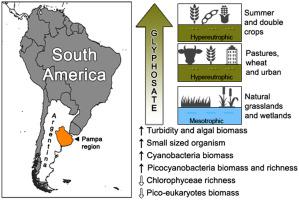Agriculture, Ecosystems & Environment ( IF 6.6 ) Pub Date : 2021-11-11 , DOI: 10.1016/j.agee.2021.107740 Manuel Castro Berman 1 , Inés O’ Farrell 2 , Paula Huber 3 , Damián Marino 4 , Horacio Zagarese 1

|
Modern agricultural practices heavily rely on the use of agrochemicals. Glyphosate based herbicides are among the most widespread agricultural supplies. The massive application of glyphosate in conventional farming, provides continuous inputs of the herbicide into the environment, unintentionally placing non-target organisms at risk. Shallow lakes immersed in agroecosystems serve as integrators of human interventions in their watersheds. Autotrophic plankton, which are key components of biogeochemical cycles and food-webs, respond quickly to anthropogenic disturbances. Here, we assessed the environmental implications and ecological consequences of agricultural land use and glyphosate contamination on phytoplankton from 52 shallow lakes scattered over 180,000 km2 across the central pampas in Argentina, which lay on areas differentially impacted by glyphosate. Indicators of glyphosate usage positively correlated with lake turbidity and Cyanobacteria abundance, and were negatively associated with Chlorophyceae diversity. Glyphosate impact indicators were also associated with higher abundance of the small-sized representatives within each major algal class, which are assumed to be better adapted to poor light conditions. Detection of the presence of GLY-transporter genes (phnD) in seston samples was associated with higher picocyanobacteria biomass and lower pico-eukaryotic algae. Our results illustrate that the observed distribution patterns of phytoplankton can be explained by the combination of the watershed’s agricultural profile, conductivity, and light quality.
中文翻译:

一项大规模的地理覆盖调查揭示了农业实践对浮游生物初级生产者的普遍影响
现代农业实践严重依赖农用化学品的使用。基于草甘膦的除草剂是最普遍的农业用品之一。草甘膦在传统农业中的大量应用,使除草剂持续输入到环境中,无意中将非目标生物置于危险之中。沉浸在农业生态系统中的浅湖是人类对其流域干预的整合者。自养浮游生物是生物地球化学循环和食物网的关键组成部分,对人为干扰反应迅速。在这里,我们评估了农业用地使用和草甘膦污染对分布在 180,000 km 2 的52 个浅湖中的浮游植物的环境影响和生态后果横跨阿根廷中部的潘帕斯草原,该地区位于受草甘膦影响不同的地区。草甘膦使用指标与湖泊浊度和蓝藻丰度呈正相关,与叶绿科多样性呈负相关。草甘膦影响指标还与每个主要藻类中小型代表的丰度较高有关,这些藻类被认为更适应弱光条件。在seston样品中检测到 GLY 转运蛋白基因 ( phnD )的存在与较高的微微蓝藻生物量和较低的微微真核藻类有关。我们的结果表明,观察到的浮游植物分布模式可以通过流域的农业剖面、电导率和光质量的组合来解释。



























 京公网安备 11010802027423号
京公网安备 11010802027423号